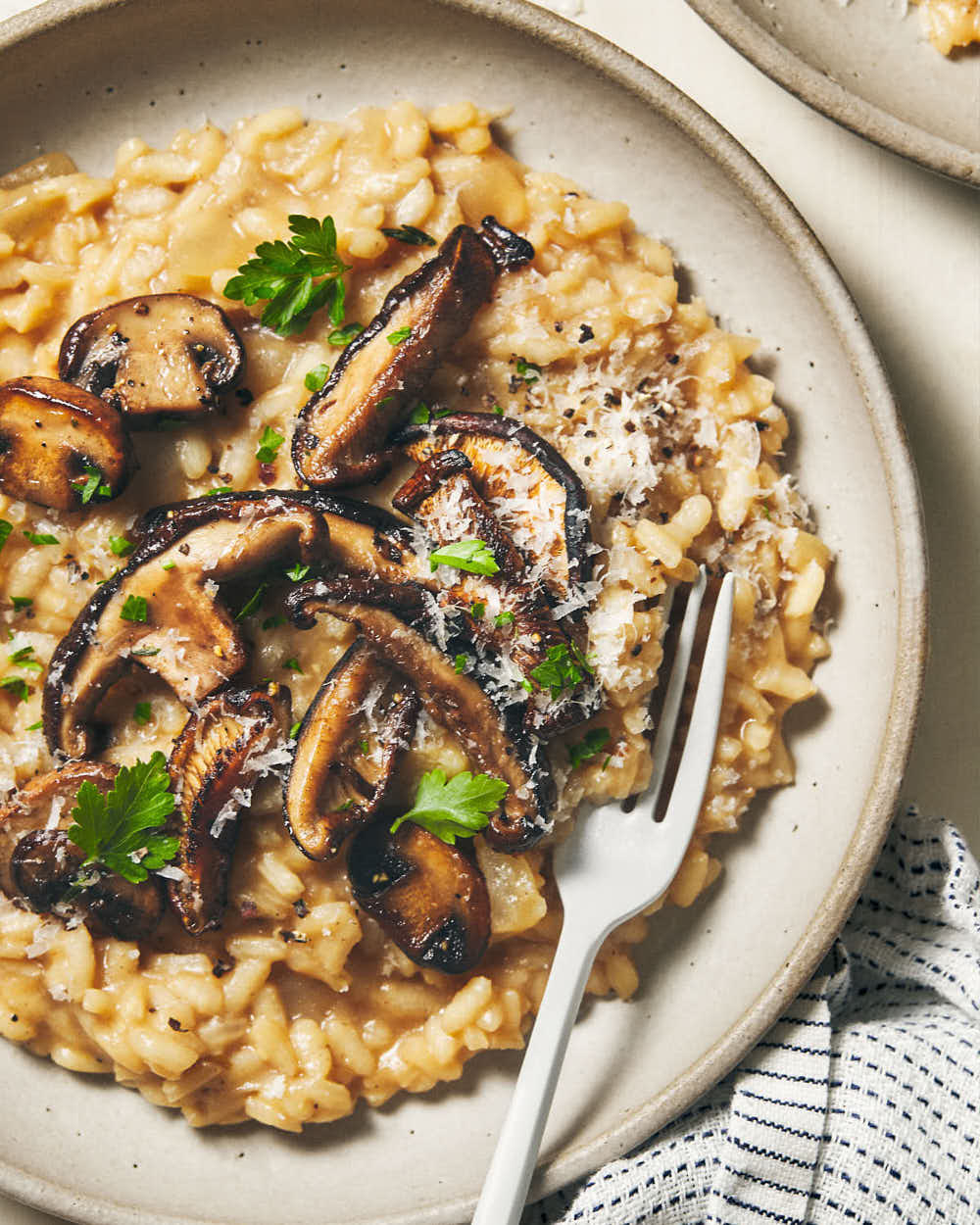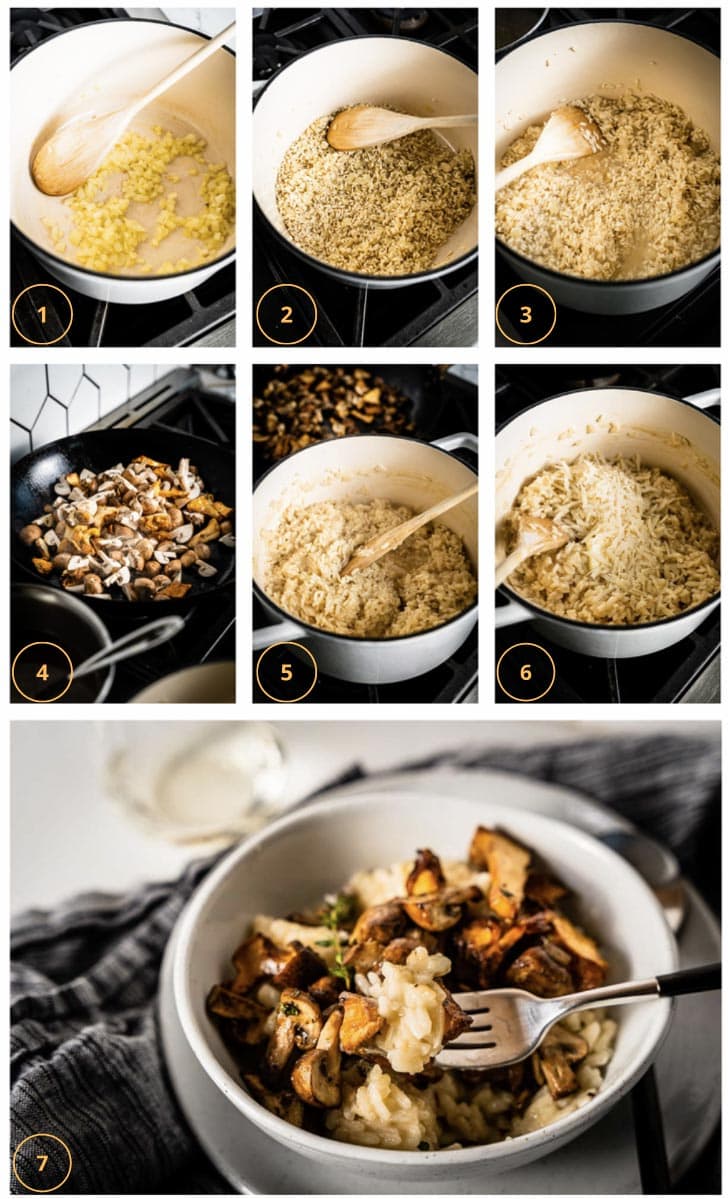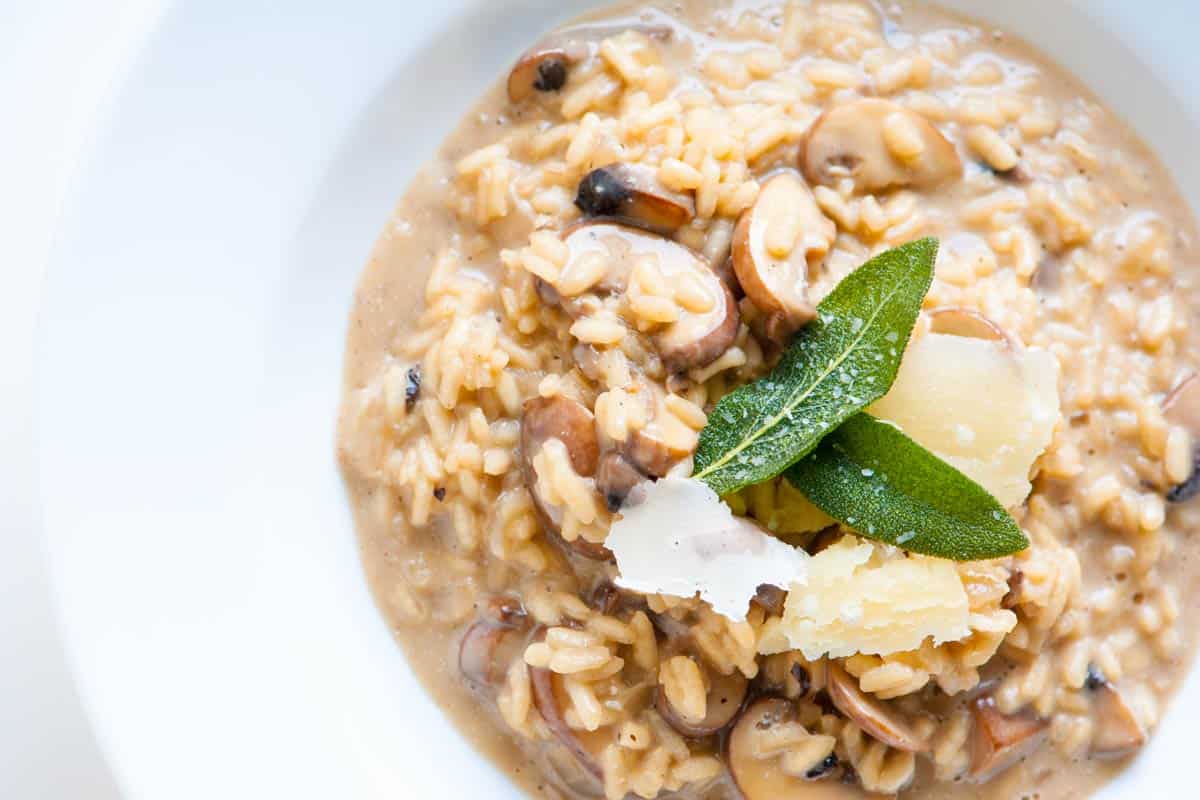
A bowl of creamy mushroom risotto, garnished with fresh parsley and Parmesan.
Risotto is one of those dishes that evokes images of cozy Italian kitchens, where the air is filled with the aroma of simmering broth and sautéed ingredients. Among its many variations, creamy mushroom risotto stands out as a beloved favorite, combining the earthy depth of mushrooms with the rich, velvety texture of Arborio rice. This dish isn’t just a meal; it’s an experience—a perfect blend of simplicity and sophistication that can elevate a weeknight dinner or impress guests at a special gathering.
In this comprehensive guide, we’ll dive deep into everything you need to know about making creamy mushroom risotto. From its historical roots in Italian cuisine to step-by-step instructions, nutritional insights, and creative twists, this article is designed to be your ultimate resource. Whether you’re a novice cook or a seasoned chef, you’ll find valuable tips to perfect this classic. We’ll also explore pairings, variations, and common pitfalls to avoid. By the end, you’ll be equipped to create a restaurant-quality risotto right in your own kitchen.
If you’re looking for more Italian-inspired recipes, check out our Classic Margherita Pizza or Homemade Pasta Dough. For external resources, the https://tastetrove.net/ provides a great overview of its cultural significance.
The Rich History of Risotto: From Ancient Roots to Modern Delight
Risotto’s story begins long before it became a staple in Italian restaurants worldwide. Rice itself was introduced to Italy by the Arabs during the Middle Ages, around the 13th to 14th centuries, when they controlled parts of Sicily and Spain. The Moors and Saracens brought rice cultivation techniques, which quickly spread northward. By the 14th century, rice was being grown in the Po Valley in northern Italy, particularly in regions like Lombardy and Piedmont, where the climate and irrigation systems were ideal for paddy fields.
The first documented recipe resembling modern risotto dates back to 1809, though oral traditions suggest it evolved much earlier. In Lombardy, rice was initially used in soups or as a simple boiled side dish. However, the technique of toasting the rice in fat and gradually adding broth—known as “risotto alla milanese”—emerged as a way to create a creamy consistency without cream. This method relies on the high starch content of short-grain rices like Arborio, Carnaroli, or Vialone Nano, which release amylopectin during cooking, giving risotto its signature creaminess.
A charming legend ties risotto to the creation of saffron risotto in 1574. According to folklore, a young apprentice glassmaker named Valerio, working on the stained-glass windows of Milan’s Duomo cathedral, was nicknamed “Zafferano” for his habit of adding saffron to his pigments for vibrant yellows. At his daughter’s wedding, he playfully added saffron to the rice dish, creating the golden-hued risotto alla milanese that became iconic. This story, while possibly apocryphal, highlights how risotto has always been adaptable, incorporating local ingredients and flavors.
Over the centuries, risotto spread across Italy and beyond. In the 19th century, as Italian immigrants traveled to the Americas, they brought recipes with them, adapting to available ingredients. Today, risotto is a global phenomenon, with variations incorporating everything from seafood to vegetables. Mushroom risotto, or “risotto ai funghi,” likely gained popularity in the forested regions of northern Italy, where wild mushrooms like porcini are abundant. It’s a testament to the dish’s versatility—simple enough for home cooks yet elegant for fine dining.
For more on the evolution of Italian cuisine, visit our History of Pasta section or explore Cuisine at Home’s guide to risotto fundamentals. Understanding this history not only adds depth to your cooking but also inspires experimentation with traditional techniques.
Nutritional Benefits: Why Mushrooms Make Risotto a Healthy Choice

Fresh mushrooms and other key ingredients for a nutritious risotto.
Beyond its indulgent taste, creamy mushroom risotto offers surprising health benefits, largely thanks to its star ingredient: mushrooms. These fungi are nutritional powerhouses, low in calories and fat while being rich in vitamins, minerals, and antioxidants. Incorporating mushrooms into risotto transforms it from a comfort food into a dish with genuine wellness perks.
Mushrooms are an excellent source of B vitamins, including riboflavin, niacin, and pantothenic acid, which support energy metabolism and red blood cell production. They’re also packed with potassium—more per serving than a banana in some varieties—which helps regulate blood pressure and supports heart health. With their low sodium content and heart-healthy compounds, mushrooms can prevent plaque buildup in arteries, reducing the risk of cardiovascular disease.
Antioxidants in mushrooms, such as ergothioneine and glutathione, combat oxidative stress and may fight cell damage, potentially lowering the risk of chronic diseases. They’re cholesterol-free, high in fiber, and contain beta-glucans that support immune function. In a risotto context, mushrooms add umami without extra calories, making the dish satisfying yet light—around 300-400 calories per serving, depending on portions.
The rice itself contributes complex carbohydrates for sustained energy, while Parmesan cheese provides protein and calcium. Opting for vegetable broth keeps it vegetarian-friendly and lower in saturated fat. Overall, mushroom risotto can be part of a balanced diet, especially when paired with greens or lean proteins.
For those watching their intake, mushrooms are versatile; varieties like shiitake or portobello enhance flavor while boosting nutrition. Check our Guide to Healthy Eating for more tips, or read Cedars-Sinai’s article on mushroom benefits. Remember, moderation is key—risotto’s creaminess comes from starch, not heavy cream, keeping it healthier than many creamy dishes.
Essential Ingredients for the Perfect Creamy Mushroom Risotto
Selecting quality ingredients is crucial for authentic risotto. Here’s a detailed list for 4 servings:
| Ingredient | Quantity | Notes |
|---|---|---|
| Arborio rice | 1 1/2 cups | Short-grain for creaminess; alternatives like Carnaroli work too. |
| Mixed mushrooms (e.g., cremini, shiitake, porcini) | 1 lb | Fresh or dried; rehydrate dried ones for intense flavor. |
| Onion or shallot | 1 medium, finely chopped | Provides base aroma. |
| Garlic | 2-3 cloves, minced | Enhances umami. |
| Vegetable or chicken broth | 6 cups | Low-sodium; homemade for best taste. See our Vegetable Broth Recipe. |
| Dry white wine | 1/2 cup | Like Pinot Grigio; optional but adds acidity. |
| Parmesan cheese | 1/2 cup, grated | Freshly grated for melting. |
| Butter | 2-3 tbsp | For sautéing and finishing. |
| Olive oil | 2 tbsp | Extra-virgin for richness. |
| Fresh parsley or thyme | 2 tbsp, chopped | For garnish and freshness. |
| Salt and pepper | To taste | Freshly ground. |
| Heavy cream (optional) | 1/4 cup | For extra creaminess, though traditional recipes skip it. |
These ingredients yield a dish that’s gluten-free and can be vegan with substitutions like dairy-free cheese. Source fresh mushrooms from local markets for optimal flavor. For more on rice varieties, link to Allrecipes’ Gourmet Mushroom Risotto.
Step-by-Step Guide: How to Make Creamy Mushroom Risotto

Step-by-step visuals of preparing mushroom risotto.
Making risotto requires patience, but the results are worth it. This recipe takes about 45 minutes and serves 4.
- Prepare the Broth and Mushrooms: Heat 6 cups of broth in a saucepan and keep it simmering. Clean and slice 1 lb of mushrooms. If using dried porcini, soak 1/2 cup in hot water for 20 minutes, then strain and reserve the liquid to add to the broth for extra umami.
- Sauté the Aromatics: In a large skillet or Dutch oven, heat 2 tbsp olive oil and 1 tbsp butter over medium heat. Add 1 finely chopped onion and cook until translucent, about 5 minutes. Stir in 2-3 minced garlic cloves for 1 minute.
- Toast the Rice: Add 1 1/2 cups Arborio rice and stir to coat with the oil, toasting for 2-3 minutes until the edges are translucent. This step releases starch for creaminess.
- Deglaze with Wine: Pour in 1/2 cup dry white wine and stir until absorbed, about 2 minutes. The wine adds depth and acidity.
- Cook the Mushrooms Separately: In a separate pan, melt 1 tbsp butter and sauté the mushrooms until golden and their liquid evaporates, about 8-10 minutes. Season with salt, pepper, and thyme. Set aside half for garnish.
- Add Broth Gradually: Ladle in 1 cup of hot broth to the rice, stirring constantly until absorbed. Repeat with remaining broth, 1/2 cup at a time, stirring frequently. This takes 18-20 minutes; the rice should be al dente—creamy but with a slight bite.
- Incorporate Mushrooms and Finish: Stir in the sautéed mushrooms, 1/2 cup grated Parmesan, and optional 1/4 cup cream. Adjust seasoning. Remove from heat and let rest for 2 minutes to thicken.
- Serve: Divide into bowls, top with reserved mushrooms, parsley, and extra Parmesan. Enjoy immediately.
This method ensures a creamy texture without constant stirring myths. For visual guidance, see RecipeTin Eats’ Mushroom Risotto.
Expert Tips and Tricks for Mastering Risotto
Achieving perfect risotto involves technique. Use hot broth to maintain cooking temperature and prevent mushiness. Stir often but not constantly—let the rice absorb liquid naturally. Taste as you go; rice doneness is personal.
Common mistakes: Overcooking leads to gluey texture; undercooking leaves it crunchy. Use the right pot—a wide, shallow one for even evaporation. For vegan versions, swap butter for oil and cheese for nutritional yeast.
Storage: Risotto is best fresh, but refrigerate leftovers up to 2 days. Reheat with broth to restore creaminess. Freeze in portions for up to a month.
For advanced tips, explore our Risotto Troubleshooting Guide or Inspired Taste’s recipe.
Delicious Variations to Elevate Your Mushroom Risotto
![Mushroom Risotto [vegan] - Contentedness Cooking](https://www.contentednesscooking.com/wp-content/uploads/2019/12/Mushroom-Risotto-steps1.jpg)
Alternative steps for a vegan mushroom risotto variation.
Mushroom risotto is endlessly adaptable. Try adding peas for color and sweetness, as in NYT Cooking’s Mushroom Risotto with Peas. For a luxurious twist, incorporate truffle oil or wild mushrooms like chanterelles.
Vegan option: Use vegetable broth, olive oil, and cashew cream. Add roasted butternut squash for autumn vibes or spinach for greens. Reddit users suggest beef broth and red wine for a hearty version with rosemary and thyme.
Instant Pot variation: Sauté in the pot, add all ingredients, and pressure cook for 6 minutes—quick and hands-off. Explore Allrecipes’ 12 Mushroom Risotto Recipes for more ideas. Link to our Vegan Recipes Collection.
Ideal Pairings: Wine, Sides, and Serving Ideas
Pair mushroom risotto with earthy reds like Pinot Noir or Nebbiolo, which complement the umami without overpowering. For whites, try lightly oaked Chardonnay or Sauvignon Blanc. Barolo or Montepulciano d’Abruzzo are excellent Italian choices.
Serve with a simple green salad, grilled asparagus, or roasted chicken. For dessert, tiramisu balances the savory notes. See Food & Wine’s pairing guide. Our Wine Pairing Basics has more.
Frequently Asked Questions About Mushroom Risotto
Can I make risotto ahead? Yes, but add extra broth when reheating.
Is risotto gluten-free? Naturally, yes, as rice is gluten-free.
What if I don’t have wine? Use broth with lemon juice for acidity.
How many calories in a serving? About 350-450, varying by additions.
For more, visit Delish’s Best Mushroom Risotto.
Conclusion: Bring Italy to Your Table

A beautifully plated creamy mushroom risotto.
Creamy mushroom risotto is more than a recipe—it’s a culinary journey rooted in history, enhanced by nutrition, and open to creativity. With the right ingredients and techniques, you can master this dish at home. Experiment, enjoy, and share your creations. For similar recipes, try our Seafood Risotto. Buon appetito!
